
Metaphor: ReFantazio Review
Metaphor: ReFantazio is an incredibly intriguing landmark release for Atlus. After an extensive development cycle since its reveal as Project Re Fantasy seven years ago, it’s a brand-new RPG with no direct ties to any of their titles. It is not a new Persona, it is not a Shin Megami Tensei spin-off, and it is not some sort of surprise sequel or follow-up to anything they have done previously.
While it may possess some of the same DNA and ideas from their other titles, Metaphor: ReFantazio ultimately amalgamates mechanics from numerous Atlus games into a fresh setting and premise with several unique systems of its own. When it was first revealed as Project Re Fantasy, Atlus publicly announced the formation of the brand-new Studio Zero internal team to spearhead its development. Since then, Studio Zero developed 2019’s Catherine: Full Body, the expanded version of Catherine that contained new content for the 2011 puzzle adventure game.

Metaphor: ReFantazio is simply excellent. I didn’t know what to expect when I first started the game, but it gradually won me over the more time I put into it. Though it has a few downfalls, I think Metaphor: ReFantazio is one of the most impressive games Atlus has ever developed.
The initial narrative setup is, admittedly, a tad convoluted. Right from the get-go, things kick off immediately with the assassination of the king in the medieval fantasy world of Euchronia. Players step into the shoes of a young man guided by a fairy named Gallica to deliver an urgent letter. Their mission eventually leads them to becoming accomplices of a counterasssassination attempt on Louis, the king’s murderer.
Though this revenge premise plays a minor part in driving the protagonist’s motivation, the real reason lies in his desire to see the royal prince take up the succession of the throne. Unfortunately, the same perpetrator to the regicide previously placed a curse on the prince that slowly eats away at his life and has put him into a comatose state. One of the ways to undo the curse is to take the life of its caster, but the plans of the protagonist’s group goes awry unexpectedly when the king’s royal magic activates from beyond the grave.
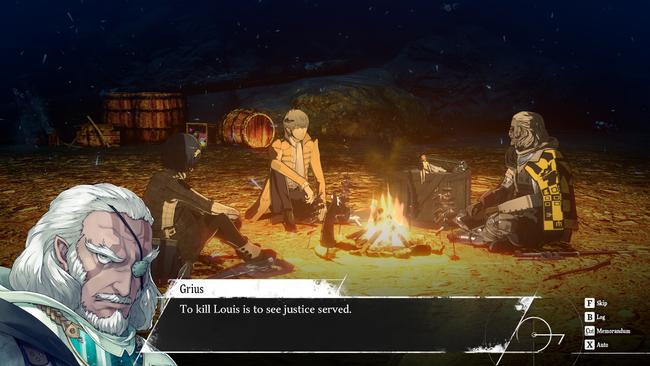
It sets a universal mandate all throughout the realm that the next ruler of Euchronia will be decided through an election. The individual that has gained the most support by a certain date will become the next king or queen; anyone throughout the land of Euchronia, no matter where they are on the social ladder, can enter. Those who are especially high on the popularity ranking, such as Louis due to his respected feats as a military commander, are protected by the late king’s royal magic that forbids him from being assaulted - assassination or otherwise.
The main character is forced to find another way to free the prince from his curse. Louis is potentially the only one who possesses an alternative cure to the prince’s condition. In order to catch his attention and tap into what he knows, the protagonist decides to enter the competition for the throne, and earn enough recognition throughout the land to catch Louis’ eye.
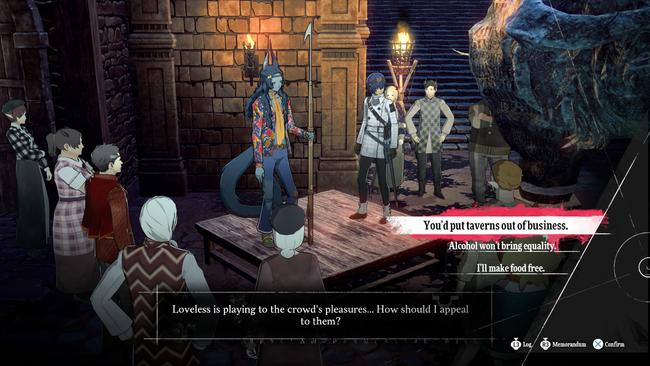
This angle of unfolding the narrative through traversing across Euchronia for an election allows Metaphor: ReFantazio to build its world and characters organically. While Atlus’ Persona and Shin Megami Tensei titles generally do a good job in this regard, their underlying settings rely on a contemporary understanding of the modern world’s societal norms and structure, and they tend to feature a main cast around the same age group and social status. Meanwhile, Metaphor: ReFantazio has built an entire fantasy world from the ground-up that revolves around eight different tribes that already has an established social hierarchy that’s understood by its population.
Discrimination runs rampant across Euchronia whether it be through tribal differences, poverty, or otherwise. It’s a matter that the game doesn’t shy away from. Metaphor: ReFantazio integrates this through gameplay as the protagonist comes from the disrespected Elda tribe that is commonly looked down upon by many other tribes. Early on, almost every NPC expresses their disdain to the protagonist interacting with them. Gameplay elements, like purifying equipment at the church to enhance their capabilities, will have the priest charge an increased rate while a certain shop initially won’t even allow the main character to access their inventory at all.
Access to magic is prohibitively restrictive on a financial basis, so it’s also fairly limited to higher social classes, too. Normally, people can’t freely cast magic spells in Metaphor: ReFantazio like in other fantasy stories. Instead, magic spells are fired off from expensive igniter devices - though the protagonist’s group are able to freely tap into magic through their own exclusive means.
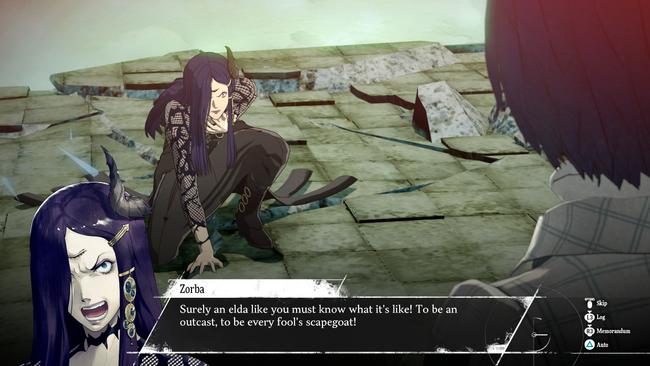
There’s a thoughtful acknowledgement that permeates through the entire game that the status quo is clearly broken and unfair in many ways, but there’s no easy solution to remedy the situation instantaneously. The main quest in Metaphor: ReFantazio isn’t a noble one, yet it highlights the trials and tribulations of doing what it takes to potentially see a brighter tomorrow. In this case, the protagonist’s group is searching for a way to undo the curse of the prince and murdering a man to do so is a solution that is not off the table. They implicitly understand the social injustices of Euchronia, and perhaps the prince will address it during his reign if they were to see him become the next king.
What makes this particularly compelling is partially because the game does a great job characterizing Louis himself right at the start. The amount of focus in highlighting his charisma and oppressive aura every time he’s on-screen is something Atlus has struggled to do in recent years for its antagonists. Although Maruki ended up becoming an intriguing villain in Persona 5 Royal, it inherently felt tacked on because his addition was part of the new expanded content in the Royal version, so its fruition came very late into the game. Meanwhile, Metaphor: ReFantazio introduces Louis as early as the opening cutscene so it creates this tense relationship with him immediately.
In addition to Louis, other candidates for the throne have their own philosophies and perspectives of a better future. Some seek to maintain the status quo, others want to tweak it to favor their side, and a few plan to crush it altogether by any means necessary. Metaphor: ReFantazio continually prods about what qualities make the ideal ruler, though it smartly doesn’t vomit outright answers down the player’s throat.
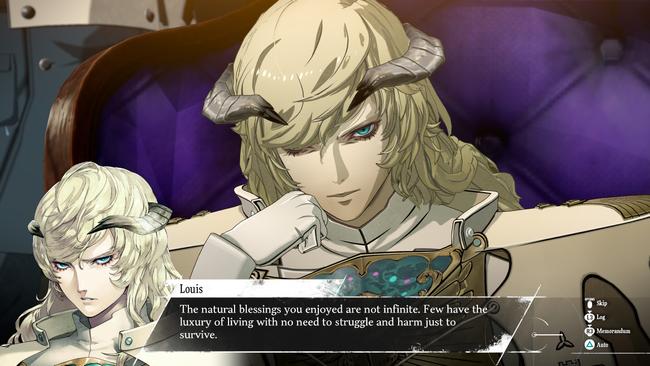
At first glance, much of the structural framework in Metaphor: ReFantazio’s moment-to-moment gameplay is borrowed from the Persona series - specifically the calendar system and the day-to-day activities that players can engage in. When the game fully opens up after its initial hours, players will spend a lot of their time deciding what to do during the afternoon and night segments of an in-game day. Activities will clearly label if they pass the time or not, so a lot of the ebb and flow in Metaphor: ReFantazio is similar to Atlus’ most popular RPG series.
There have been several enhancements to its formula that grant Metaphor: ReFantazio a distinct feel and cadence apart from Persona. First and foremost, there isn’t a high school; instead, people will find themselves in several towns, villages, or cities as the story moves along. During their temporary stay at each locale, players can choose to spend their in-game days either engaging in Metaphor: ReFantazio’s equivalent of a Social Link through raising a Follower’s bond rank, participating in activities that increase their protagonist’s social stats, or start traveling on their Gauntlet Runner vehicle towards a new dungeon to explore.
A key feature that Metaphor: ReFantazio possesses over Persona is the time investment it takes to get from one place to the other. When it’s time to move to a new location, people direct a massive Gauntlet Runner landship to travel along a predetermined route and it can take multiple days to get to their destination. Therefore, people also have to take into account the time it takes to travel when confined to the Gauntlet Runner, as well. While the calendar system is mechanically similar to Persona, the way it’s been used in Metaphor: ReFantazio provides a fulfilling sense of going from place to place on a journey.

Atlus is a bit cheeky in how they explain some of the “video game” stuff in Metaphor: ReFantazio. For instance, all the music the player hears in the game is a spell cast by Gallica on the protagonist and though its world acknowledges that the concept of music was the first magic brought into it, music possessed no practical utility so rarely anyone utilizes that spell. The overall soundtrack reminded me of the harmonies found in Shin Megami Tensei: Strange Journey, though I must admit that I still have mixed feelings on the rapid chanting in many of Metaphor: ReFantazio’s tracks even now.
It’s a tiny fun in-game explanation for being able to hear its tunes obviously, but there are some elements where it’s a little far-reaching and outlandish. When fast traveling back to past locations is unlocked for example, the in-game explanation is absurd; I do somewhat admire their attempt at even trying to contextualize it. Since several followers and specific vendors only live in a certain place, it’d be a hassle to burn in-game days constantly traveling back and forth to spend time with them so the fast travel function is much appreciated of course, yet I found the reasoning for it to be quite amusing nonetheless. Besides the ability to fast travel to past locales, there’s a handy feature that allows people to instantaneously travel to any equipment shop, tavern, and other significant places of interest too.
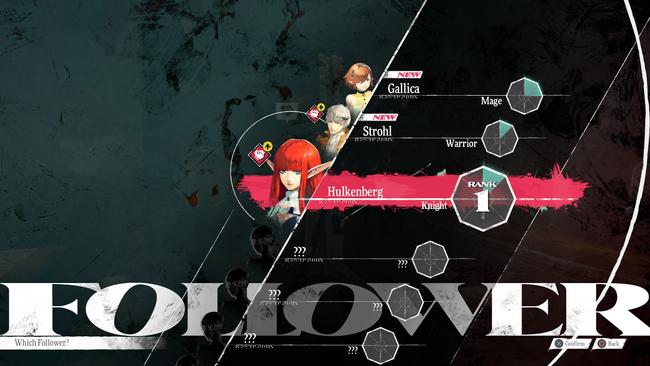
As I briefly mentioned earlier, Metaphor: ReFantazio does have its own version of Persona’s Social Links through earning new Followers. This game clearly signifies when a Follower is ready to rank up their bond level with the player, and each of them feeds into one of the Archetype job classes that I’ll detail later.
One of the most noteworthy aspects of the Follower system in Metaphor: ReFantazio is that unlike Persona’s Social Links, it does not have a hidden affection meter to reach the next threshold to rank them up. This ostensibly means that there are no “best dialogue choices” that directly affect how soon a player can level their bond with a Follower. The only factors that determine whether they’re eligible to be ranked up is the usual social stat gates at later ranks, and whether the player is in town or traveling to somewhere in the Gauntlet Runner. Some Follower rank up scenes can only be initiated during the Gauntlet Runner traversal phase.
Don’t get me wrong; there are still numerous dialogue options that give the player a little something for responding well to a Follower. Instead of raising affection, responding “correctly” grants a bonus amount of MAG. This MAG resource is spent on unlocking new Archetypes and transferring skills from one Archetype to another; it’s something a player gets in abundance by normally playing, so there’s no need to stress about picking all the “right options” for dialogue choices here.

Metaphor: ReFantazio gets a lot of mileage out of its setting and premise in order to establish one of the best Social Link-esque rosters in an Atlus game yet. People from varying age groups, tribes, social positions, and occupations from different parts of Euchronia all interact with the main character to share their experiences and views. Characters often find themselves suffering from tragedies and trying to find a way to process their grief. One Follower is another candidate that is trying to find a way for her dwindling tribe to survive, while another is a former disgraced knight searching for a place to put his late son’s ashes to rest.
The general tone of Followers’ stories often leans more tragic and heartbreaking than Persona’s Social Links. They highlight the unforgiving nature of Euchronia and how people struggle, cope, or bear with the injustices they’ve faced. When Atlus shared that Metaphor: ReFantazio wouldn't allow players to pursue romantic relationships like in Persona, several people took issue with it - but I think the absence of this choice strengthens how relationships with Followers unfold. Giving me the option to date a grieving father that’s still struggling to process the death of his kid as I’m trying to save the prince would feel out of place.
Nevertheless, I do still have some of the same issues with Followers as I did with Social Links and Confidants in Persona. I wish there was a bit more intermingling with other characters in several of them; a lot of them still boil down to only the main character and the Follower interacting with one another. Only the first and final rank events are fully voiced, which stings a bit when Persona 3 Reload earlier this year had all of its Social Link events voiced.
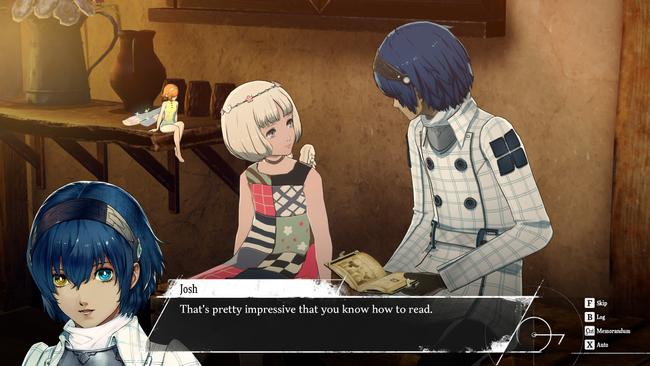
Moving on from how similar Metaphor: ReFantazio is to Persona, the biggest and most exciting departure from it is through its gameplay. The game blends real-time action and turn-based combat seamlessly in a manner that’s very reminiscent of how Nihon Falcom’s The Legend of Heroes: Trails through Daybreak handles it.
Although Metaphor: ReFantazio gives the option to activate the turn-based “Squad” combat immediately upon encountering an enemy on the field, it’s usually preferable to hit them enough times to stun them first. If an enemy lands a hit on the player though, they’ll immediately gain the advantage into the turn-based mode, instead. Things go by much faster if the player has a significant level advantage over their targeted foes; hitting them out on the field will kill them right away and the rewards a player gets are identical to what they would have received if they prevailed over that weaker enemy in turn-based mode. If that weaker enemy hits the player first, they only receive a tiny fraction of damage on the field and cannot get ambushed into turn-based mode like usual.
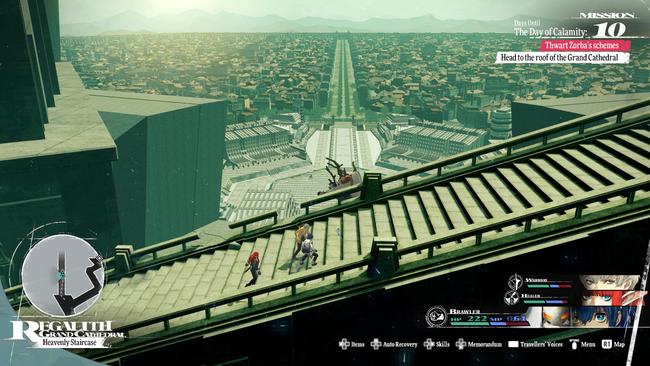
This allows dungeon exploration and navigation to fly by much faster, especially because stunned enemies don’t have to be engaged at all. People can simply stun foes to navigate around them safely. Depending on which Archetype the protagonist has equipped, their weapon out on the field will change. Each different type of Archetype has a unique passive skill that only applies to the real-time action mode for the main character. For example, the Mage Archetype Lineage that contains the Mage, Wizard, and its two Elite classes all restore a tiny bit of MP if the protagonist stuns or vanquishes a foe in action mode, while the Brawler Archetype Lineage with the Brawler, Pugilist, and its Elite class staggers larger enemies out on the field more often.
Every individual Archetype Lineage has its own unique set of weapons, and each of them have distinct movesets in the action side of combat. Of course, don’t expect something as intricate or complex as other dedicated action RPGs; it’s deliberately a bit stiff, since there aren’t animation cancels because it wants people to consider the risk of being hit during their swing or backing off first.
On the turn-based side of combat, it’s a fascinating mixture of Atlus’ Shin Megami Tensei and Etrian Odyssey series. While it does utilize the Press Turn mechanic from Shin Megami Tensei, the overall flow is different because of the presence of a front row and back row position like in Etrian Odyssey. Those in the front row deal increased melee damage at the cost of reduced defense, while the back row is the inverse. On a character’s turn, they can freely switch between each row before committing to an action. Staples of the Press Turn battle system remain otherwise. Hitting an enemy’s elemental weakness only consumes half a Press turn, as well as passing a turn to the next party member.
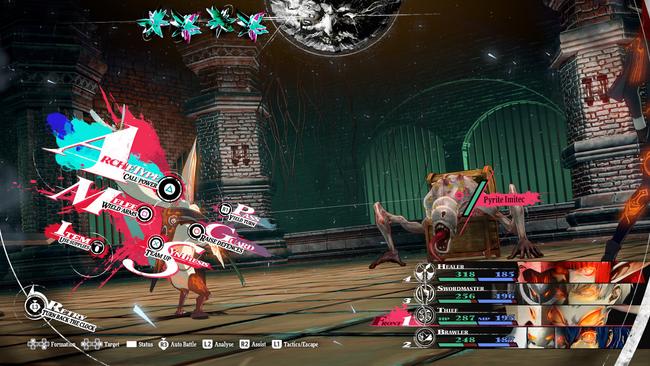
A returning feature not seen since Atlus’ Digital Devil Saga games are the combination Synthesis skills that allow multiple party members to cast a particularly potent ability at the cost of each of their turns. Shin Megami Tensei V: Vengeance did have combination skills as well, but their utility was tied to the Magatsuhi meter in that game, so they couldn’t be cast as freely as how Digital Devil Saga and Metaphor: ReFantazio handle it. Combination skills in Digital Devil Saga did require specific abilities from its party members to access them though; on the other hand, Synthesis skills in Metaphor: ReFantazio only require a certain mix of job classes in a person’s party. It’s a fairly robust system that allows people to access higher-tier abilities early on at the expense of consuming multiple turns simultaneously.
I truly enjoyed Metaphor: ReFantazio’s approach to battles. Enemies hit hard, and bosses have a variety of patterns that encourage people to adapt their strategies on the fly. One boss encounter may have its allies be the actual threat instead of the boss itself, while another boss may try to overwhelm players with an onslaught of buffs and debuffs every single turn it gets. There are even boss fights that have a mandatory special condition to them that further pushes people to experiment with party compositions or setups that they may not be initially comfortable with.
My only issue with this game's turn-based battles is that there’s an instant retry option for every fight that’s easily abusable. I don’t mind the option on principle, but it can too-easily negate poor decision-making. If an individual opens up the fight with an attack option that the enemy repels, they can just retry the fight immediately from the start and the game will remember that the enemy repels that attribute. I’m not entirely sure what a decent compromise would be; its current implementation feels too forgiving as such.
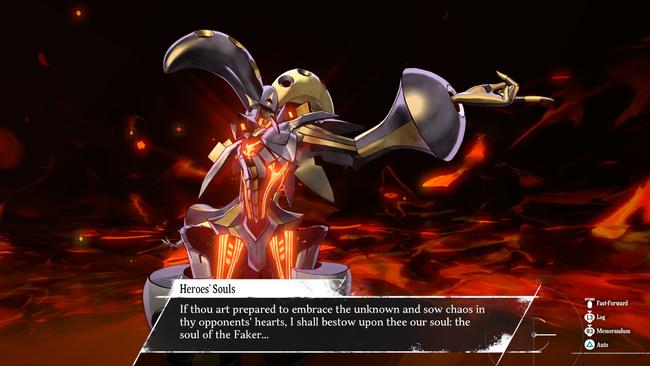
The aforementioned Archetype job class system in Metaphor: ReFantazio is a huge element that had me smiling the entire way through. Archetypes may come across as Personas at first glance, but their function is more akin to traditional RPG classes that happen to have slick avatars to represent them. Players will continually unlock new Archetypes through ranking up Followers. Archetypes are separated by Lineages, so each of these jobs eventually unlock some sort of advanced or upgraded version that possess better skills and abilities.
It doesn’t necessarily overshadow the earlier version of the jobs in some cases, because later classes can change up the Synthesis skills available to them. In my playthrough, the Pugilist Archetype had an amazing non-elemental AoE Synthesis skill that was oddly replaced by an electric version in its subsequent Elite class, so it actually became less useful in some situations because certain enemies took less or no damage because they resisted or nullified electric attacks.
Each Archetype Lineage has its own set of predetermined attributes it’s strong and weak against, and every single person in the party can freely change up their Archetypes by spending MAG. People can even have the same Archetype multiple times in the party; if an entire party composed of only Mages sounds appealing, Metaphor: ReFantazio absolutely supports it.

As people continually increase the rank of their bond with Followers, each Archetype Lineage gradually obtains more slots for players to transfer skills from other Archetypes into. An Archetype Lineage can eventually support up to 4 skill inheritance slots, so there’s a ton of versatility in crafting party compositions and specializations. Once a skill is learned by a character on any given Archetype, it can be immediately transferred over to another Archetype at the cost of some MAG.
A lot of Metaphor: ReFantazio’s gameplay progression is tied to the discovery of finding and unlocking new Archetypes. Some are unabashed nods to Atlus’ previous works; a few of them even have special mechanics tied to them.
Leveling up each Archetype doesn’t feel like a chore, either. Some RPGs with multiple job selections may fall in the trap of constantly switching a character to a fresh level 1 job again after fully leveling up two or three other jobs previously, so it’s hard to feel a sense of reward, payoff, or satisfaction from it. After an Archetype has been fully leveled up in Metaphor: ReFantazio, that character can continue to earn Archetype EXP (A-EXP) for it. For every 1000 A-EXP it earns, the mastered Archetype will give a consumable item to players that they can then spend on any other Archetype equipped to any character which grants that same 1000 A-EXP it earned. It’s an extremely smart design choice I appreciate that allows people to maintain their party formation and synergy, while they invest the A-EXP they accumulate in however way they want.
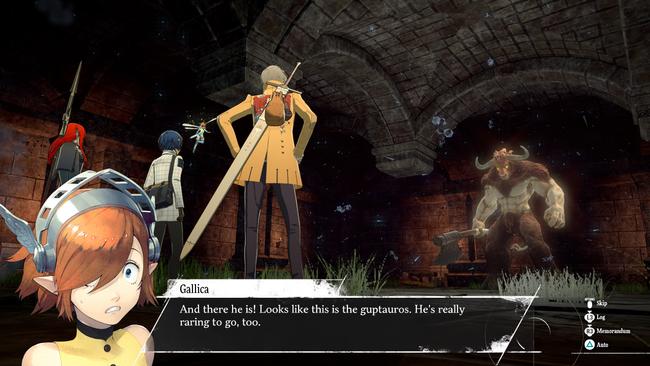
What caught me off-guard in Metaphor: ReFantazio is how much of a dungeon crawler it is and no, I don’t mean that in a bad way whatsoever. A lot of the major story dungeons are not only extensive in their own ways, but their format introduces a degree of variety I wasn’t expecting. I won’t spoil any surprises of course; all I’ll say is that the early segments of how the format is presented is not quite indicative of how it will always be for the rest of the game.
I was relieved to see Atlus return to some of their roots - lengthy dungeons filled with an array of puzzles, and secret passages to enter optional areas full of loot. Recent titles in their catalog, such as Shin Megami Tensei V and Soul Hackers 2, did not scratch my itch for satisfactory dungeon experiences; Metaphor: ReFantazio, on the other hand, did to some extent. It never quite reached the peaks that Etrian Odyssey and Shin Megami Tensei: Strange Journey did, and I did find myself wishing that its dungeons were a bit crueler in that regard.
Aside from the big story dungeons, there are many other smaller ones unlocked from side quests. These don’t take as much time, yet their map layouts are pretty interesting to chart out and explore. The actual environment itself for these minor dungeons does become repetitive; expect to see similar looking caverns and forest areas for a lot of them.
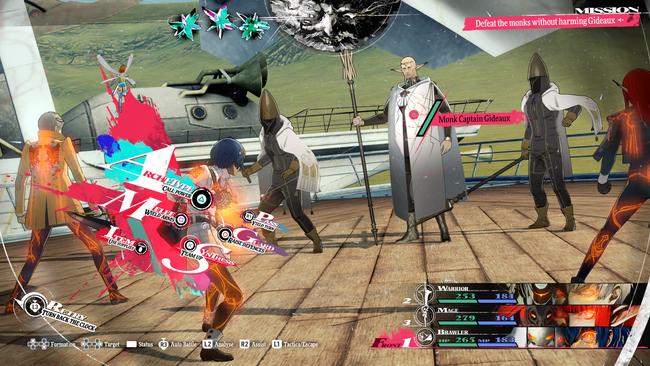
Something I do appreciate from the dungeons in Metaphor: ReFantazio are how enemies are assorted. It isn’t shy in having packs of enemies wander around together, or numerous creatures organized in a line formation to diegetically convey that there is a form of understood hierarchy that’s been formed in the dungeon itself. Due to the combat system having a real-time action aspect to it, the game feels comfortable in densely populating its dungeons.
Another clever method Atlus employs to weave the “video game” part of Metaphor: ReFantazio into its world building are the helpful informants in taverns. They sell a variety of helpful intel, including hints on where to go for side quests, what sorts of monsters are in specific dungeons, and maybe even what the weaknesses of a boss are. It’s effectively a partial “Analyze” function that finds the right balance of sharing just enough to give players a heads-up without spoiling all of a dungeon’s surprises.
The overall aesthetic of Metaphor: ReFantazio comes together elegantly. Numerous medieval fantasy races are dressed in outfits inspired by the fashion trends seen during the UK’s Swinging Sixties. Common creatures seen in fantasy, such as goblins, minotaurs, griffins, and dragons, roam the land. The Gauntlet Runner landships are vehicles composed of attaching a giant beast’s legs and tail onto the ship themselves, so they travel across the land similar to how a lizard moves. Akademeia, the Velvet Room equivalent, draws heavy inspirations from Leonardo da Vinci’s Vitruvian Man especially in the Archetype Tree interface itself. It’s a compelling reimagining that challenges several preconceptions of what a medieval fantasy world is supposed to look like.
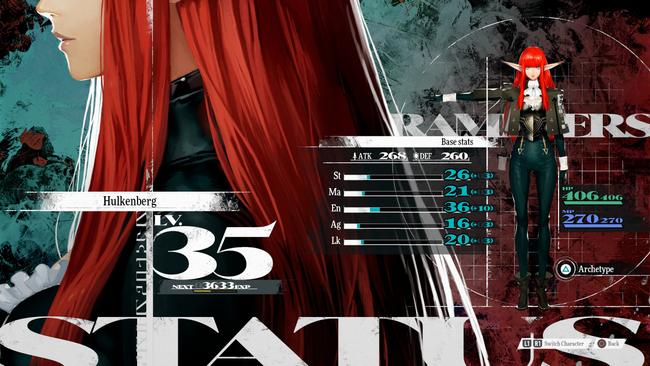
After Persona 5 sparked a revolution of how a stylish user interface can elevate a game’s experience without sacrificing its utility, numerous other games throughout the video game industry followed in its footsteps. Atlus applied that same design philosophy in Persona 3 Reload, and the same is true in Metaphor: ReFantazio.
Although I was initially concerned that it looked too busy, it actually comes together quite nicely when playing the game. Menus are responsive, snappy, and quickly communicate what each screen does to the player. There’s a painterly motif to its menu themes this time around that sets it apart from how they approached Persona 5 and Persona 3 Reload; it’s gorgeous and most importantly, easy to read. Navigating the Archetype Tree menu was the only egregious offender because when I’m trying to remember which Archetype has a certain skill I want to learn for a character, that interface is not the most intuitive thing to menu through.
I also love the art direction of all the character portraits. Its painted approach helps define the look of Metaphor: ReFantazio apart from any of their past works… sometimes to its detriment. Their vibrancy creates a stark contrast to their in-game models. I’m well aware of the long development cycle that Atlus faced with Metaphor: ReFantazio, and time has not been kind to its graphical fidelity.

While the UI implementation and art direction are definitely strong points, character models and the general look of its towns are merely passable in comparison. Some of its open outdoor environments are especially muddy. Every time I visited the deck of the Gauntlet Runner, the graphical quality of its surroundings were exceedingly poor; I was shocked. Thankfully it’s such a tiny part of the overall package that it doesn’t get in the way of anything meaningful. Nevertheless, it’s a clear weakness when compared to the rest of the game’s presentation.
Constant aliasing plagued Metaphor: ReFantazio in my PC review copy on Steam if I wanted it to run smoothly. In order to maintain a stable framerate without using any external third-party solutions or mods, I set the rendering scale to 100% with a 1440p resolution. Cranking the rendering scale up to 200% helped iron out the edges at the cost of my performance wildly dipping to as low as 25fps in certain sections. It’s an unfortunate trade-off that seems to be rectifiable on PC as people have already created solutions for the various performance issues with its demo, and I’m not sure what the situation is like for its console versions. Atlus has released several patches here and there that did little to fix my experience.
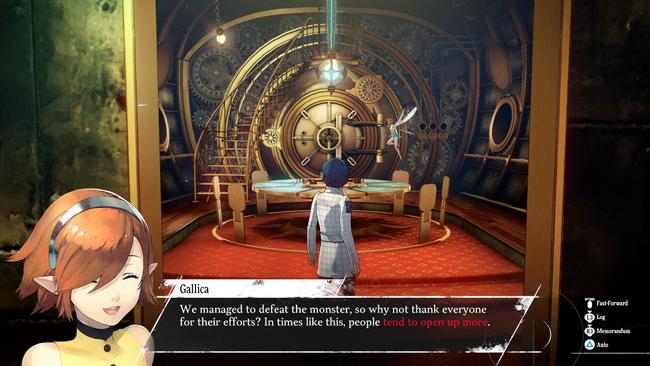
Metaphor: ReFantazio is an amazing game. I fully completed it in 75 hours and enjoyed it the entire way through. Though it may suffer from a few blemishes, such as its lackluster graphical fidelity in some areas and performance optimization issues, what it brings to the table is utterly compelling. It is a huge RPG adventure that celebrates Atlus’ history as it combines some of the best ideas from many of its previous titles into a lovely fantasy setting. The amount of detail put into Metaphor: ReFantazio’s worldbuilding and characters is captivating. Plus, the flow of its combat system’s interactions with the extensive Archetype job classes is a ton of fun. I’m always a big fan of when developers decide to tackle a brand-new IP, and Atlus knocked it out of the park with Metaphor: ReFantazio.